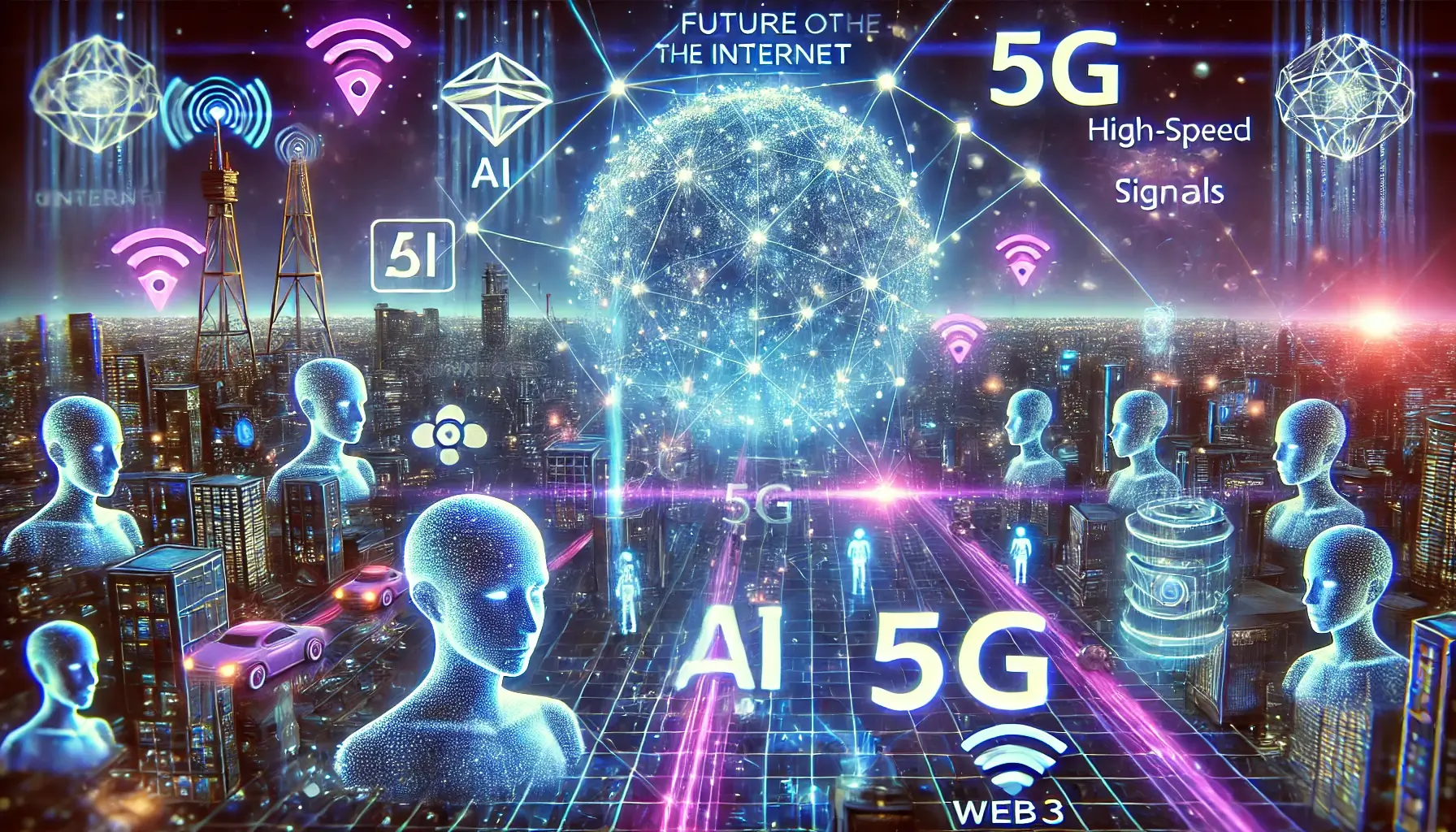-
How Digital Nomads Are Redefining Work and Lifestyle 🌍💻
Mar 06, 2025 | 39 Comments -
How Artificial Intelligence is Transforming Healthcare 🏥🤖
Mar 06, 2025 | 0 Comments -
How Cryptocurrency is Reshaping the Global Economy 💰🌍
Mar 06, 2025 | 0 Comments -
How to Build a Strong Personal Brand: Stand Out & Grow Your Influence 🚀📢
Mar 02, 2025 | 0 Comments -
The Power of AI in Business: How Artificial Intelligence is Transforming Industries 🚀🤖
Mar 02, 2025 | 0 Comments -
How Smart Homes Are Changing the Way We Live 🏡🔋
Mar 02, 2025 | 0 Comments -
How Electric Vehicles Are Revolutionizing Transportation 🚗⚡
Mar 02, 2025 | 0 Comments -
The Future of Renewable Energy: How Green Technology is Changing the World 🌍⚡
Mar 02, 2025 | 0 Comments

The Future of the Internet: How AI, 5G, and Web3 Are Transforming Online Connectivity
The internet is evolving rapidly, with artificial intelligence (AI), 5G connectivity, and Web3 technologies reshaping how people interact online. From decentralized networks to ultra-fast communication, these innovations are setting the foundation for a smarter, more secure, and user-centric digital future.
The Evolution of Internet Technologies
The internet has gone through multiple transformations, from static web pages to interactive platforms and now towards decentralization and AI-driven automation. The future of the internet is focused on improving speed, security, and accessibility.
Key Technologies Shaping the Internet
Several groundbreaking technologies are driving the evolution of online connectivity.
1. Artificial Intelligence in Web Development
AI is revolutionizing web experiences by personalizing content, improving search engine algorithms, and enhancing cybersecurity.
- AI-powered chatbots provide real-time assistance to users.
- Machine learning optimizes website performance and SEO.
- AI-driven cybersecurity prevents online threats and fraud.
2. 5G and Ultra-Fast Connectivity
5G technology is transforming internet speeds, reducing latency, and enabling new possibilities in online communication.
- 5G-powered IoT devices enable smart cities and automation.
- High-speed internet enhances video streaming and gaming experiences.
- 5G networks support seamless cloud computing and AI operations.
3. Web3 and Decentralized Internet
Web3 represents the next generation of the internet, focusing on decentralization, blockchain security, and user control over data.
- Blockchain-based domains prevent censorship and hacking.
- Decentralized applications (DApps) eliminate reliance on centralized servers.
- Cryptographic wallets secure user identities and financial transactions.
The Role of Blockchain in Web3
Blockchain technology is a core component of Web3, offering secure and transparent digital transactions.
1. Decentralized Finance (DeFi)
DeFi platforms enable peer-to-peer financial transactions without traditional banking intermediaries.
- Smart contracts automate secure financial agreements.
- Cryptocurrencies offer borderless digital payments.
- Blockchain lending platforms replace traditional banks.
2. Secure Digital Identity
Web3 allows users to control their personal data and digital identities.
- Self-sovereign identity solutions enhance online privacy.
- Decentralized authentication replaces password-based logins.
- AI and blockchain work together to verify user authenticity.
3. NFT and Digital Ownership
Non-fungible tokens (NFTs) allow users to own digital assets on blockchain networks.
- NFTs provide proof of ownership for virtual goods.
- Artists and creators monetize digital content through NFT marketplaces.
- Blockchain gaming uses NFTs for virtual in-game assets.
Cybersecurity and Privacy in the Future Internet
As internet technology evolves, cybersecurity threats also become more sophisticated. AI and encryption methods are essential for safeguarding user data.
1. AI in Cybersecurity
AI-driven security systems detect and neutralize cyber threats in real time.
- Machine learning algorithms identify phishing attempts.
- AI-based firewalls enhance network security.
- Predictive analytics prevent ransomware attacks before they occur.
2. Zero Trust Security Model
The Zero Trust model assumes that no user or device should be trusted by default.
- Multi-factor authentication adds extra security layers.
- Encryption ensures safe communication and transactions.
- Network access is continuously monitored for suspicious activity.
3. Data Privacy Regulations
Governments and organizations are implementing stricter data protection policies.
- GDPR enforces user data rights in the European Union.
- California’s CCPA gives users control over their personal data.
- Blockchain privacy tools prevent unauthorized data access.
Future Internet Trends and Predictions
The internet will continue evolving with emerging technologies that enhance user experience and connectivity.
1. AI-Powered Search Engines
AI will revolutionize online searches with better accuracy and contextual understanding.
- Voice search will dominate online queries.
- AI-driven search engines personalize results based on user behavior.
- Neural networks improve natural language processing in searches.
2. Metaverse and Virtual Reality
The metaverse will redefine digital interactions, allowing users to explore virtual environments.
- AI avatars create realistic social interactions.
- Decentralized virtual economies emerge in online worlds.
- VR and AR improve online shopping, gaming, and collaboration.
3. Edge Computing and Internet Infrastructure
Edge computing reduces latency and improves real-time data processing.
- Cloud-based applications operate with lower response times.
- AI and 5G optimize global connectivity.
- Smart cities use edge computing for real-time analytics.
Conclusion
The future of the internet is being shaped by AI, 5G, and Web3 innovations. As decentralized networks, blockchain security, and AI-driven automation continue to evolve, online interactions will become faster, safer, and more personalized. Businesses, developers, and users must stay informed and adapt to emerging digital trends to thrive in the next generation of internet technology.
0 comments
No comments yet. Be the first to comment!
Your comment